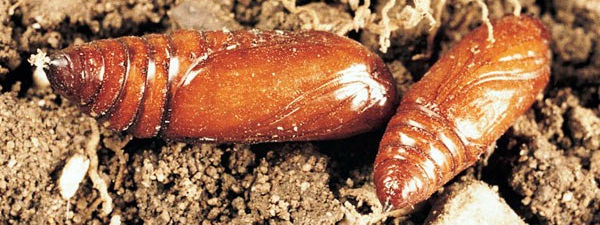Black Cutworms Pose Threat to Corn
September 3, 2019

Although several cutworm species can attack corn across the United States, the black cutworm (Agrotis ipsilon spp.) poses the most significant economic threat. Research shows that just one black cutworm larva feeding on corn can cut through as many as four young corn stalks in its lifetime.
Black cutworms are most often found in corn and cotton, yet it can cause problems in wheat, tobacco and some vegetable crops. Even though severe infestations rarely occur, black cutworm should be on a farmer’s list of corn insect pests to monitor.
Identification and Lifecycle
Black cutworms are a common corn pest throughout the Corn Belt and in the South. The black cutworm species ranges from light gray to black in color, and larvae are 1-1/2 inches long when fully grown.
More than 45 days are required for eggs to develop into larvae and adult moths. After the pupal stage, adult moths emerge and lay eggs on surrounding weeds, patches of grass and crop residue. Eggs may be laid even before crops are planted. The first generation of adult moths are the most damaging. Black cutworms produce three to four generations per season.
Typically, black cutworms overwinter in Gulf Coast states and migrate northward as early as February. Most migration occurs in April and May. In July and August, second and third generations thrive. The final generation flies south as temperatures drop.
Crop Damage
Black cutworm larvae spend the day just beneath the soil surface, feeding on corn and cotton seedlings, which then likely wilt and die. When soil moisture is adequate, the larvae climb to just above the soil surface at night to feed and cut off the young plants at the base. Although plant loss in infested corn fields can range from 10 to 80 percent, a complete field loss is unlikely. Severe black cutworm damage usually only occurs in patches within a field.
Scouting
Begin scouting for black cutworms soon after crop emergence. Look just below the soil surface where black cutworms can chew into a seedling and pull it under a soil clod or hole to feed on it. Pay extra attention to late-planted fields and those with early-season weeds. Refer to university Extension weekly and monthly reports for scouting guidelines and economic thresholds for insecticide treatments in specific corn- and cotton-growing geographies.
Best Management Practices to Control
In no-till or limited-till situations, black cutworms may become established in the soil, overwinter and feed on newly planted seedlings. Because a wide variety of vegetation – including redroot pigweed and other weeds – are hosts for black cutworm, remove existing crop residue and control weeds through tillage, a burndown herbicide and residual preplant herbicides.
Taking out existing vegetation prior to planting will also provide better penetration of insecticide spray or granules. Season-long weed control helps prevent black cutworms from causing crop damage and harming yields and will help improve effectiveness of in-season insecticide treatments.
The best approach to managing black cutworms in corn is prevention.
Hybrids, varieties and seed traits
Farmers should consult with their seed dealer and review university Extension field trials to evaluate Bt corn and Bt cotton seed choices, plus non-Bt seed options, to help control black cutworm.
Seed treatments
Starting off with a good seed treatment is an excellent way to control insects and protect corn above and below the ground. Seed treatments labeled for black cutworm will go a long way to protect young seedlings.
Insecticides
Baythroid® XL insecticide, a pyrethroid, performs on a broad spectrum of corn insect pests, with fast knockdown and long residual control. You may want to consider a postemergence rescue application when three percent or more field damage occurs and larvae still continue to feed. Follow IPM guidelines and always rotate insecticides with different modes of action to effectively manage insecticide resistance in combination with other control practices.
Always read and follow label instructions. Not all products are registered for use in every state. Baythroid XL is a Restricted Use Pesticide.